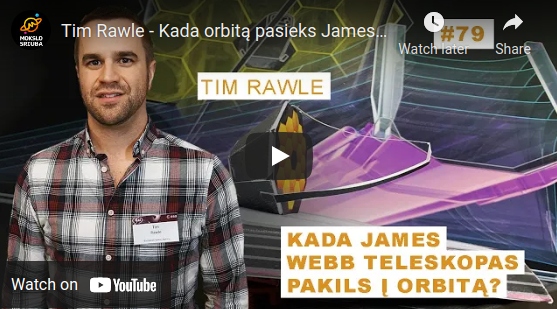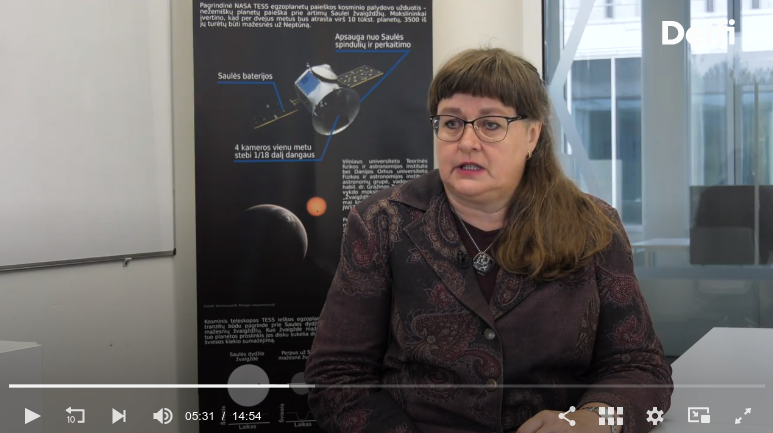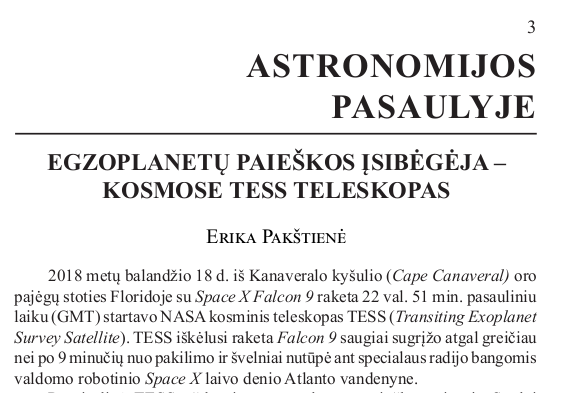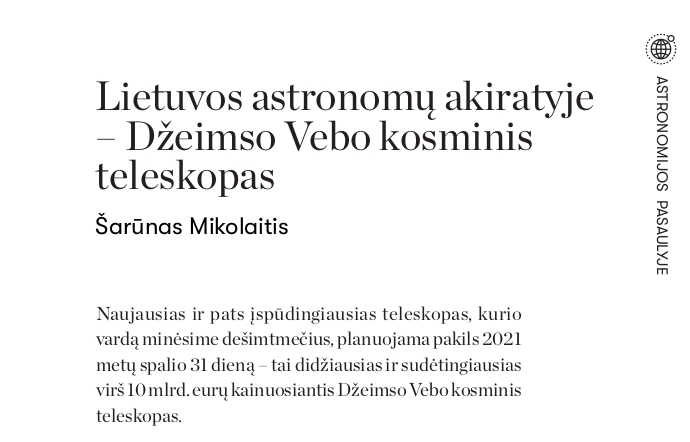JWST Master Class local workshop in Lithuania for Baltic states was organized on February 20-21, 2020 in Vilnius, Vilnius University.
The JWST proposal planning tools (APT and ETC) are quite complex. Therefore a 2-day workshop was organized in Vilnius, Lithuania in order to train participants on how to use these proposal tools and to stimulate proposal ideas. In a 2 day workshop where JWST experts trained selected researchers from ESA member states on JWST proposal planning tools, resources and documentation. Topics of the workshop: JWST mission status and instruments: NIRCam, NIRSpec, NIRISS, MIRI, available proposal tools and end-to-end tools usage, available observing science modes and observing strategies.
Material of the Master Class can be found here: http://mao.tfai.vu.lt/masterclass

Participants of the MasterClass
Outreach podcast of the MasterClass with Tim Rawle - ESA [English with Lithuanian subtitles]
JWST science
- Galactic chemodynamical evolution
- Galactic Archeology and ancient substructures
- Extra mixing processes in evolved stars
- RS CVn type stars
- Open cluster studies
- Exoplanets
Galactic chemodynamical evolution
The formation and evolution of galaxies is one of the great unsolved problems of modern astrophysics. The only galaxy available for detail studies is our Milky Way Galaxy, but our Galaxy is complex structure and evidently undergone very complicated formation history.
Low mass stars have long lifetimes, comparable to the age of the Galaxy and their atmospheres have preserved much of their original chemical composition. These stars are ‘fossils’ containing information about chemical composition of galactic material at the moment of birth of these stars. Therefore low to intermediate mass stars of different ages preserved information about a history of evolution of the Galaxy in their chemical composition.
(Papers)
- Pagel, Tautvaisiene 1995 http://adsabs.harvard.edu/abs/1995MNRAS.276..505P
- Pagel, Tautvaisiene, 1997 http://adsabs.harvard.edu/abs/1997MNRAS.288..108P
- Pagel, Tautvaisiene, 1998 http://adsabs.harvard.edu/abs/1998MNRAS.299..535P
- Tautvaisiene et al, 2007 (galaktika IC 1613) http://adsabs.harvard.edu/abs/2007AJ....134.2318T
- Puzeras, et al, 2010 http://adsabs.harvard.edu/abs/2010MNRAS.408.1225P
Galactic Archeology and ancient substructures
Our Milky Way Galaxy is complex structure and evidently undergone very complicated formation history. Galactic Archeology attempts to reveal that history by reconstructing the lost stellar substructures of the Galaxy, thereby backtracking formation processes. ‘Signposts’ of historic evolutionary events are chemically and dynamically linked stellar substructures. Those ‘fossil’ substructures are identified and backtracked to former evolutionary events by combining together stellar chemical analysis data and dynamical analysis. Stars formed together have same chemical composition, thereby if star-forming aggregates have unique ‘chemical signatures’, we can use chemical composition to ‘tag’ disk stars to a common formation event.
- (Archeologija I) http://adsabs.harvard.edu/abs/2012A%26A...541A.157S
- (Archeologija II) http://adsabs.harvard.edu/abs/2013A%26A...555A...6S
- (Archeologija III) http://adsabs.harvard.edu/abs/2014A%26A...563A..53Z
- (Archeologija IV) http://adsabs.harvard.edu/abs/2015A%26A...576A.113Z
Extra mixing processes
Stellar evolution is caused by nuclear reactions in stellar cores slowly changing the internal stellar composition and structure. Mixing processes in stellar interiors can change properties of stellar material and structure, and can influence evolution of the star. As stellar evolution models are widely used in the modern stellar astrophysics, mixing processes potentially could have a wide impact on various seemingly unrelated astrophysical problems.
Investigation into abundances of mixing-sensitive elements can independently verify stellar evolution models. Numerous modern observations provide compelling evidence of additional or ‘extra’ mixing process in the low–mass red giant (RGB) stars unpredicted by standard evolution model, i.e. evidence that the standard stellar evolution model is incomplete
(papers)
- http://adsabs.harvard.edu/abs/2001A%26A...380..578T
- (Red clump CNO, mixing) http://adsabs.harvard.edu/abs/2010MNRAS.409.1213T
- (Red clump CNO, mixing II) http://adsabs.harvard.edu/abs/2013MNRAS.430..621T
RS CVn type stars
- http://adsabs.harvard.edu/abs/2010BaltA..19...95T
- http://adsabs.harvard.edu/abs/2010BaltA..19..157B
- http://adsabs.harvard.edu/abs/2011BaltA..20...53B
- http://adsabs.harvard.edu/abs/2011AN....332..925T
Open clusters
Open clusters are important tools for the study of the Galactic disk as well as for understanding of stellar evolution. Since cluster members initially were of identical chemical composition, all changes in stellar atmospheres are related to internal and external processes of stellar evolution.
- http://adsabs.harvard.edu/abs/2000A%26A...360..499T
- http://adsabs.harvard.edu/abs/2004AJ....127..373T
- http://adsabs.harvard.edu/abs/2005A%26A...431..933T
- http://adsabs.harvard.edu/abs/2010MNRAS.407.1866M
- http://adsabs.harvard.edu/abs/2011MNRAS.413.2199M
- http://adsabs.harvard.edu/abs/2011MNRAS.416.1092M
- http://adsabs.harvard.edu/abs/2012A%26A...541A.137M
- http://adsabs.harvard.edu/abs/2015A%26A...577A..47B
Exoplanets
The characterisation of discovered exoplanets by TESS or other space missions employing HST or VLT spectroscopic data is very important and challenging goal. This kind of analysis is an important preaparation for work with the high-resolution planet transit spectra to be obtained with the NASA/EAS/CAS James Webb Space Telescope.
BalticGrid
Astrospectroscopy group of VU ITPA.
The BOCCE project is aimed at obtaining in the most homogeneous way the properties (age, distance, reddening, metallicity and detailed elemental abundances) of a sample of (mostly old) Galactic Open Clusters. A detailed description of our program and the results of the first part of the photometric survey can be found in Bragaglia & Tosi (2006).
The clusters observations can be divided in three parts:
(1) PHOTOMETRY : multiband optical CCD photometry (usually BVI)
(2) LOW-RED SPECTROSCOPY: multi object spectra to derive radial velocity and membership
(3) HIGH-RES SPECTROSCOPY: to measure metallicity and detailed chemical composition
Age, distance, reddening and a first indication of metallicity are obtained using the synthetic colour-magnitude diagram technique (as developed in Tosi et al. 1991).
Results of the first 20 OCs can be found in Table 1
The CMDs for the first 20 OCs can be seen here
High-res spectra (This email address is being protected from spambots. You need JavaScript enabled to view it. ESO, UVES@VLT, SARG@TNG, with R=30000-48000) have been obtained for 3-6 red clump stars per cluster. [Fe/H] and detailed metallcities for several clusters have been determined. See Table 2 for a list of the clusters already analyzed.
MOS with LRS@TNG has been used to derve RVs of stars in key evolutionary phases (Be 29, Be 32, Be 17 done up to now)
The list of papers related to the BOCCE project can be found here : (link to publication list)
The Figure below indicates the position of the BOCCE clusters in the MW, with the Galactic Center at 0,0 and the Sun at 8 kpc from the center. The different colour/symbols indicate the advancement of the study of a particular cluster.
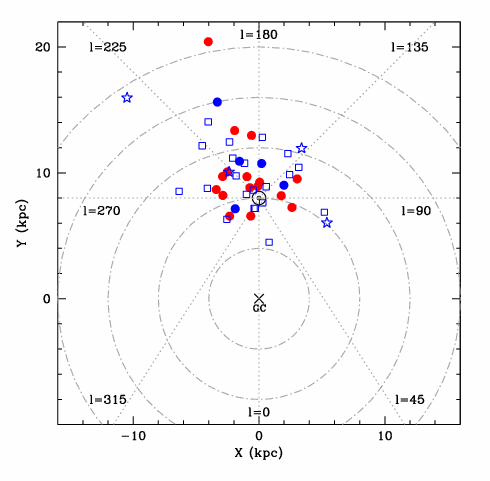

The Gaia-ESO Public Spectroscopic Survey will obtain high quality spectroscopy of some 100,000 Milky Way stars, in the field and in open clusters, down to magnitude 19, systematically covering
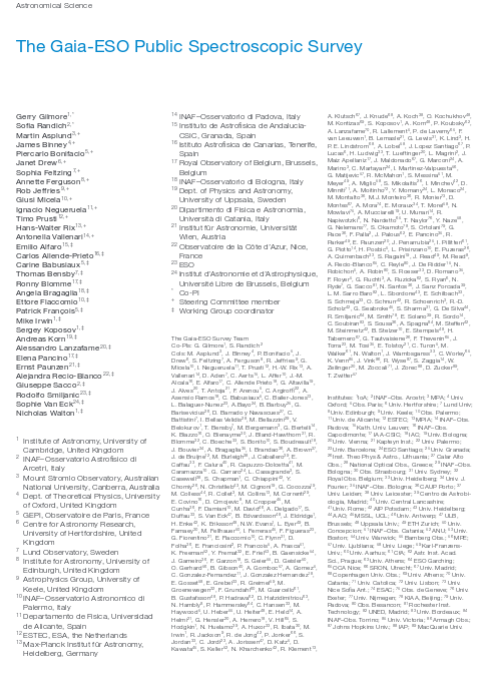 major components of the Milky Way. This survey will provide the first homogeneous overview of the distributions of kinematics and chemical element abundances in the Galaxy.
major components of the Milky Way. This survey will provide the first homogeneous overview of the distributions of kinematics and chemical element abundances in the Galaxy.
The Vilnius node of the survey adds significant input in the survey results:
We are one of the nodes, that provides main atmospheric parameters and chemical abundances for stars observed using UVES spectrograph. Specifically we are the only node to derive carbon and nitrogen abundances form molecular lines.
Together with Nice node we derive abundances from GIRAFFE spectra. Our common work is 1/3 of the input for GIRAFFE abundance analysis. We are mostly interested in Galactic abundance gradients.
Members of Vilnius group:
Gražina Tautvaišienė - group leader
Markus Ambrosch
Vilius Bagdonas
Yuriy Chorniy
Arnas Drazdauskas
Šarūnas Mikolaitis
Renata Minkevičiūtė
Edita Stonkutė
Carlos Viscasillas Vázquez
What we achieved? Our recent achievements are already in a number of Gaia-ESO papers:
-
2022MNRAS.509.1664J
The Gaia-ESO Survey: Membership probabilities for stars in 63 open and 7 globular clusters from 3D kinematics
- Jackson, R. J.; Jeffries, R. D.; Wright, N. J. 26 more
Gaia-ESO Survey: Detailed elemental abundances in red giants of the peculiar globular cluster NGC 1851
- Tautvaisiene, G.; Drazdauskas, A.; Bragaglia, A. 24 more
Gaia-ESO survey: Lithium abundances in open cluster Red Clump stars
- Magrini, L.; Smiljanic, R.; Franciosini, E. 25 more
The Gaia-ESO Survey: Galactic evolution of lithium from iDR6
- Romano, D.; Magrini, L.; Randich, S. 31 more
The Gaia-ESO Survey: a new approach to chemically characterising young open clusters. II. Abundances of the neutron-capture elements Cu, Sr, Y, Zr, Ba, La, and Ce
- Baratella, M.; D'Orazi, V.; Sheminova, V. 32 more
The Gaia-ESO survey: Mixing processes in low-mass stars traced by lithium abundance in cluster and field stars
- Magrini, L.; Lagarde, N.; Charbonnel, C. 42 more
The Gaia-ESO Survey: Oxygen Abundance in the Galactic Thin and Thick Disks
- Franchini, Mariagrazia; Morossi, Carlo; Di Marcantonio, Paolo 18 more
The Gaia-ESO Survey: Galactic evolution of lithium at high metallicity
- Randich, S.; Pasquini, L.; Franciosini, E. 20 more
The Gaia-ESO Survey: an extremely Li-rich giant in globular cluster NGC 1261
- Sanna, N.; Franciosini, E.; Pancino, E. 16 more
The Gaia-ESO survey: the non-universality of the age-chemical-clocks-metallicity relations in the Galactic disc
- Casali, G.; Spina, L.; Magrini, L. 36 more
The Gaia-ESO Survey: a new approach to chemically characterising young open clusters. I. Stellar parameters, and iron-peak, α-, and proton-capture elements
- Baratella, M.; D'Orazi, V.; Carraro, G. 33 more
The Gaia-ESO Survey: Carbon Abundance in the Galactic Thin and Thick Disks
- Franchini, Mariagrazia; Morossi, Carlo; Di Marcantonio, Paolo 24 more
The Gaia-ESO survey: Calibrating a relationship between age and the [C/N] abundance ratio with open clusters
- Casali, G.; Magrini, L.; Tognelli, E. 51 more
The Gaia-ESO Survey: The inner disc, intermediate-age open cluster Pismis 18
- Hatzidimitriou, D.; Held, E. V.; Tognelli, E. 34 more
VizieR Online Data Catalog: NGC6530 member parameters from Gaia-ESO survey (Prisinzano+ 2019)
- Prisinzano, L.; Damiani, F.; Kalari, V. 33 more
The Gaia-ESO Survey: Age spread in the star forming region NGC 6530 from the HR diagram and gravity indicators
- Prisinzano, L.; Damiani, F.; Kalari, V. 33 more
The Gaia-ESO Survey: impact of extra mixing on C and N abundances of giant stars
- Lagarde, N.; Reylé, C.; Robin, A. C. 30 more
The Gaia-ESO Survey: The N/O abundance ratio in the Milky Way
- Magrini, L.; Vincenzo, F.; Randich, S. 31 more
The Gaia-ESO Survey: the origin and evolution of s-process elements
- Magrini, L.; Spina, L.; Randich, S. 45 more
The Gaia-ESO Survey: properties of newly discovered Li-rich giants
- Smiljanic, R.; Franciosini, E.; Bragaglia, A. 41 more
The Gaia-ESO Survey: evidence of atomic diffusion in M67?
- Bertelli Motta, C.; Pasquali, A.; Richer, J. 37 more
The Gaia-ESO Survey: open clusters in Gaia-DR1 . A way forward to stellar age calibration
- Randich, S.; Tognelli, E.; Jackson, R. 42 more
The Gaia-ESO Survey: Lithium enrichment histories of the Galactic thick and thin disc
- Fu, X.; Romano, D.; Bragaglia, A. 32 more
The Gaia-ESO Survey: matching chemodynamical simulations to observations of the Milky Way
- Thompson, B. B.; Few, C. G.; Bergemann, M. 39 more
VizieR Online Data Catalog: Gaia-ESO Survey in 7 open star cluster fields (Randich+, 2018)
- Randich, S.; Tognelli, E.; Jackson, R. 43 more
The Gaia-ESO Survey: Galactic evolution of sulphur and zinc
- Duffau, S.; Caffau, E.; Sbordone, L. 48 more
The Gaia-ESO Survey: radial distribution of abundances in the Galactic disc from open clusters and young-field stars
- Magrini, L.; Randich, S.; Kordopatis, G. 44 more
VizieR Online Data Catalog: Gaia-ESO Survey. Trumpler 23 (Overbeek+, 2017)
- Overbeek, J. C.; Friel, E. D.; Donati, P. 33 more
The Gaia-ESO Survey. Mg-Al anti-correlation in iDR4 globular clusters
- Pancino, E.; Romano, D.; Tang, B. 24 more
VizieR Online Data Catalog: Gaia-ESO Survey abundances radial distribution (Magrini+, 2017)
- Magrini, L.; Randich, S.; Kordopatis, G. 44 more
The Gaia-ESO Survey: the inner disk, intermediate-age open cluster Trumpler 23
- Overbeek, J. C.; Friel, E. D.; Donati, P. 33 more
The Gaia-ESO Survey: CNO Abundances in Open Clusters of our Galaxy
- Drazdauskas, A.; Tautvaišienė, G.; Mikolaitis, Š. 5 more
The Gaia-ESO Survey: Hydrogen lines in red giants directly trace stellar mass
- Bergemann, Maria; Serenelli, Aldo; Schönrich, Ralph 27 more
The Gaia-ESO Survey: revisiting the Li-rich giant problem
- Casey, A. R.; Ruchti, G.; Masseron, T. 48 more
The Gaia-ESO Survey: the selection function of the Milky Way field stars
- Stonkutė, E.; Koposov, S. E.; Howes, L. M. 26 more
The Gaia-ESO Survey: Inhibited extra mixing in two giants of the open cluster Trumpler 20?
- Smiljanic, R.; Franciosini, E.; Randich, S. 32 more
The Gaia-ESO Survey: Probes of the inner disk abundance gradient
- Jacobson, H. R.; Friel, E. D.; Jílková, L. 41 more
VizieR Online Data Catalog: Gaia-ESO Survey. Parameters for cluster members (Jacobson+, 2016)
- Jacobson, H. R.; Friel, E. D.; Jilkova, L. 41 more
The Gaia-ESO Survey: Sodium and aluminium abundances in giants and dwarfs. Implications for stellar and Galactic chemical evolution
- Smiljanic, R.; Romano, D.; Bragaglia, A. 40 more
VizieR Online Data Catalog: Gaia-ESO Survey: Tr 20, NGC4815, NGC6705 (Tautvaisiene+, 2015)
- Tautvaisiene, G.; Drazdauskas, A.; Mikolaitis, S. 30 more
The Gaia-ESO Survey: chemical signatures of rocky accretion in a young solar-type star
- Spina, L.; Palla, F.; Randich, S. 23 more
The Gaia-ESO Spectroscopic Survey: CNO abundances in giants of the multiple-population globular cluster NGC 1851
- Tautvaisiene, Grazina; Drazdauskas, Arnas; Lardo, Carmela 3 more
The Gaia-ESO Survey: Insights into the inner-disc evolution from open clusters
- Magrini, L.; Randich, S.; Donati, P. 37 more
The Gaia-ESO Survey: Detailed abundances in the metal-poor globular cluster NGC 4372
- San Roman, I.; Muñoz, C.; Geisler, D. 28 more
The Gaia-ESO Survey: CNO abundances in the open clusters Trumpler 20, NGC 4815, and NGC 6705
- Tautvaišienė, G.; Drazdauskas, A.; Mikolaitis, Š. 30 more
The Gaia-ESO Survey: the chemical structure of the Galactic discs from the first internal data release
- Mikolaitis, Š.; Hill, V.; Recio-Blanco, A. 31 more
The Gaia-ESO Survey: α-abundances of metal-poor stars
- Jackson-Jones, R.; Jofré, P.; Hawkins, K. 21 more
The Gaia-ESO Survey: The analysis of high-resolution UVES spectra of FGK-type stars
- Smiljanic, R.; Korn, A. J.; Bergemann, M. 99 more
VizieR Online Data Catalog: Abundances from Gaia-ESO Survey (Mikolaitis+, 2014)
- Mikolaitis, S.; Hill, V.; Recio-Blanco, A. 31 more
The Gaia-ESO Survey: Stellar content and elemental abundances in the massive cluster NGC 6705
- Cantat-Gaudin, T.; Vallenari, A.; Zaggia, S. 52 more
The Gaia-ESO Survey: Metallicity of the Chamaeleon I star-forming region
- Spina, L.; Randich, S.; Palla, F. 37 more
VizieR Online Data Catalog: Gaia-ESO Survey: NGC6705 (Cantat-Gaudin+, 2014)
- Cantat-Gaudin, T.; Vallenari, A.; Zaggia, S. 52 more
The Gaia-ESO Survey: radial metallicity gradients and age-metallicity relation of stars in the Milky Way disk
- Bergemann, M.; Ruchti, G. R.; Serenelli, A. 44 more
Gaia-ESO Survey: Properties of the intermediate age open cluster NGC 4815
- Friel, E. D.; Donati, P.; Bragaglia, A. 34 more
The Gaia-ESO Survey: Abundance ratios in the inner-disk open clusters Trumpler 20, NGC 4815, NGC 6705
- Magrini, L.; Randich, S.; Romano, D. 49 more
The Gaia-ESO Survey: Reevaluation of the parameters of the open cluster Trumpler 20 using photometry and spectroscopy
- Donati, P.; Cantat Gaudin, T.; Bragaglia, A. 34 more
The Gaia-ESO Public Spectroscopic Survey
- Gilmore, G.; Randich, S.; Asplund, M. 273 more
Research schools
We host astronomical research courses and summer schools for PhD students. The course are aimed students in their PhD studies, and contain lectures by internationally top scientists, observations, exercises and assignments based mostly on own observations. The participants, who will end the Course with a successful presentation of work on the large assignment will be recommended to 6 ECU credits towards a doctoral degree. Typically all telescopes of Molėtai astronomical observatory are employed, together with remote observations using Nordic Optical and Teide telescopes in Canary Islands. Our site at Molėtai Astronomical Observatory usually hosts a summer schools every year (e.g. NordForsk, NEON, AstroBiology, BalticGrid). Read more @ mao.itpa.lt/schools/
Public outreach
We host annual public open events in Molėtai Astronomical observatory:
European Researchers' Night is a Europe-wide public event dedicated to popular science and fun learning. It takes place each year on the last Friday in September. More than 30 countries and over 300 cities are involved. For our visitors we are giving the chance get updated with the latest astronomical news and ask their own questions, visit telescopes of Observatory, and observe some interesting astronomical objects through amateur telescopes. Thus, our site in Molėtai Astronomical observatory offers public lectures, observations and many more activities for up to 800 visitors during one night every year. Also, we host a number of smaller public events (e.g. public eclipse observations, Hubble 25th anniversary…).
Molėtai Astronomical Observatory is our main public outreach and educational program center. Observatory is located about 70 km. away from Vilnius. http://mao.tfai.vu.lt/mao/en
What it is?
What we do?
Our papers about it.
What it is?
What we do?
Our papers about it.
Astrospectroscopy and Exoplanets Group works focuses its activities on these scientific research areas:
Material mixing processes in atmospheres of evolved stars.
Chemical evolution of the Milky Way.
Main atmospheric parameters and chemical composition of planet-harbouring stars.
Characterization of exoplanets and their transits.
Papers published by the group (link to NASA ADS)
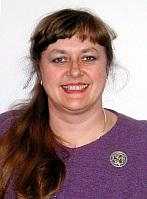
habil dr. Gražina Tautvaišienė
Professor, Chief Researcher
Office: B430
Phone: +370 5 2234666
E-mail: This email address is being protected from spambots. You need JavaScript enabled to view it.
Website: https://www.ff.vu.lt/en/itpa/staff/tautvaisiene

dr. Rimvydas Janulis
Senior Researcher
Office: B427
E-mail: This email address is being protected from spambots. You need JavaScript enabled to view it.
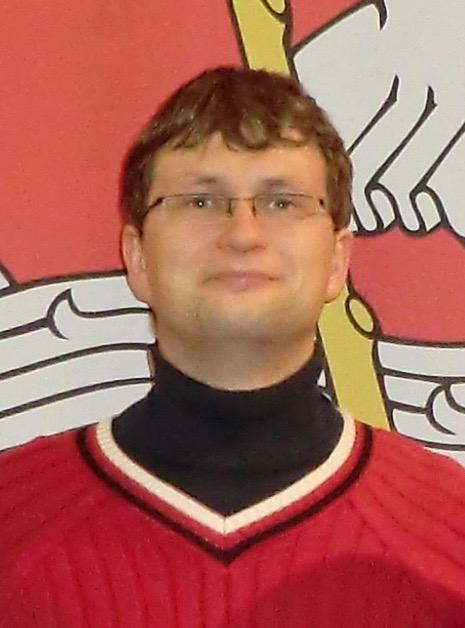
dr. Šarūnas Mikolaitis
Senior Researcher
Office: B432
E-mail: This email address is being protected from spambots. You need JavaScript enabled to view it.
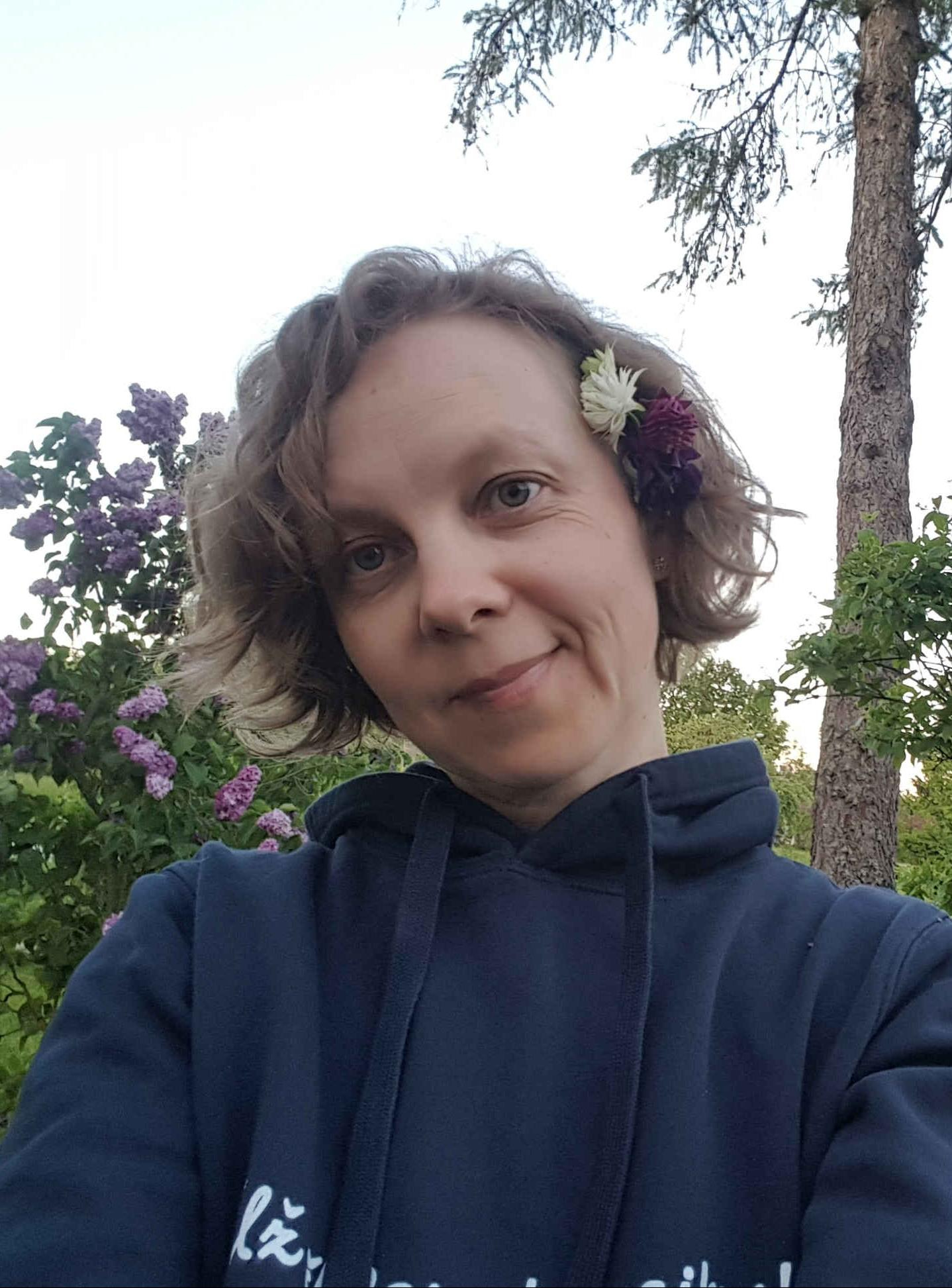
dr. Renata Minkevičiūtė
Senior Researcher
Office: B433
Phone: +370 5 2234670
E-mail: This email address is being protected from spambots. You need JavaScript enabled to view it.
Website: https://www.ff.vu.lt/en/itpa/staff/minkeviciute
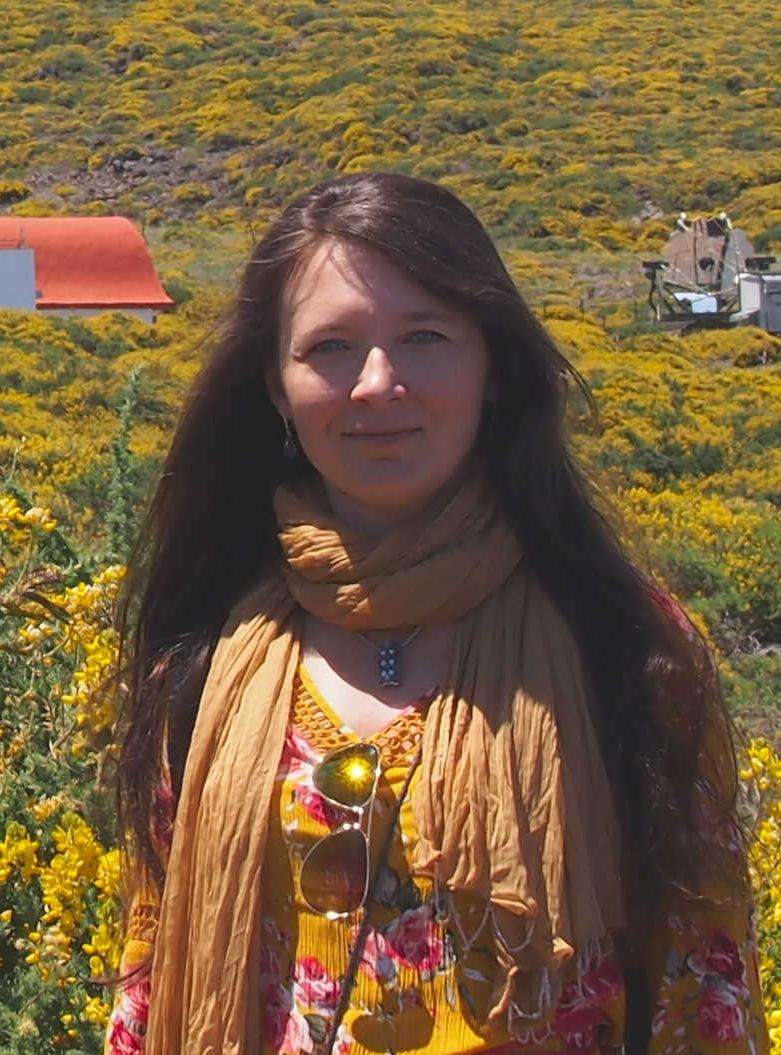
dr. Erika Pakštienė
Senior Researcher
Office: B427
E-mail: This email address is being protected from spambots. You need JavaScript enabled to view it.
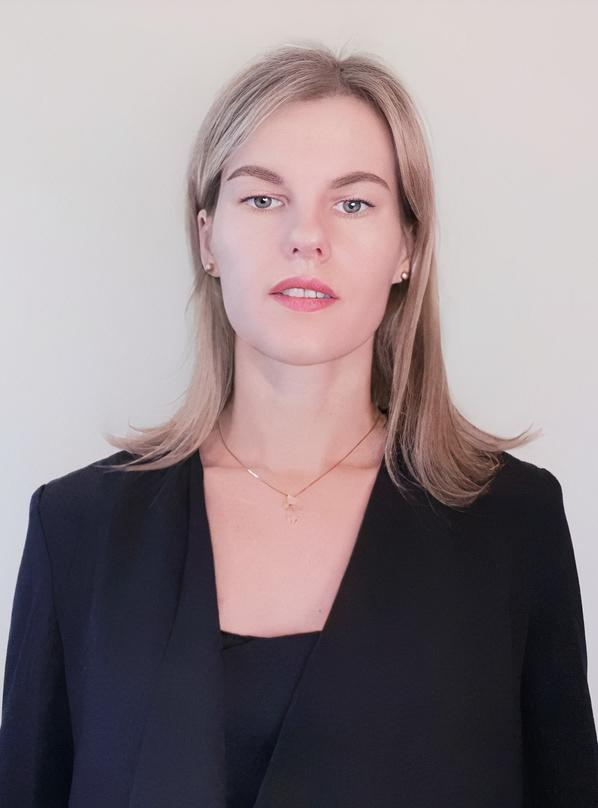
dr. Edita Stonkutė
Senior Researcher
Office: B433
Phone: +370 5 2234670
E-mail: This email address is being protected from spambots. You need JavaScript enabled to view it.
Website: https://www.ff.vu.lt/en/itpa/staff/estonkute

dr. Arnas Drazdauskas
Senior Researcher
Office: B432
Phone: +370 5 2234669
E-mail: This email address is being protected from spambots. You need JavaScript enabled to view it.
Website: https://www.ff.vu.lt/en/itpa/staff/drazdauskas
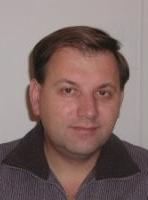
dr. Yuriy Chorniy
Researcher
Office: B428
Phone: +370 5 2234668
E-mail: This email address is being protected from spambots. You need JavaScript enabled to view it.

Carlos Viscasillas Vazquez
Researcher
Office: B428
Phone: +370 5 2234668
E-mail: This email address is being protected from spambots. You need JavaScript enabled to view it.
Website: https://www.ff.vu.lt/en/itpa/staff/viscasillas

Markus Ambrosch
Junior Researcher
Office: B416
E-mail: This email address is being protected from spambots. You need JavaScript enabled to view it.
Website: https://www.ff.vu.lt/en/itpa/staff/ambrosch
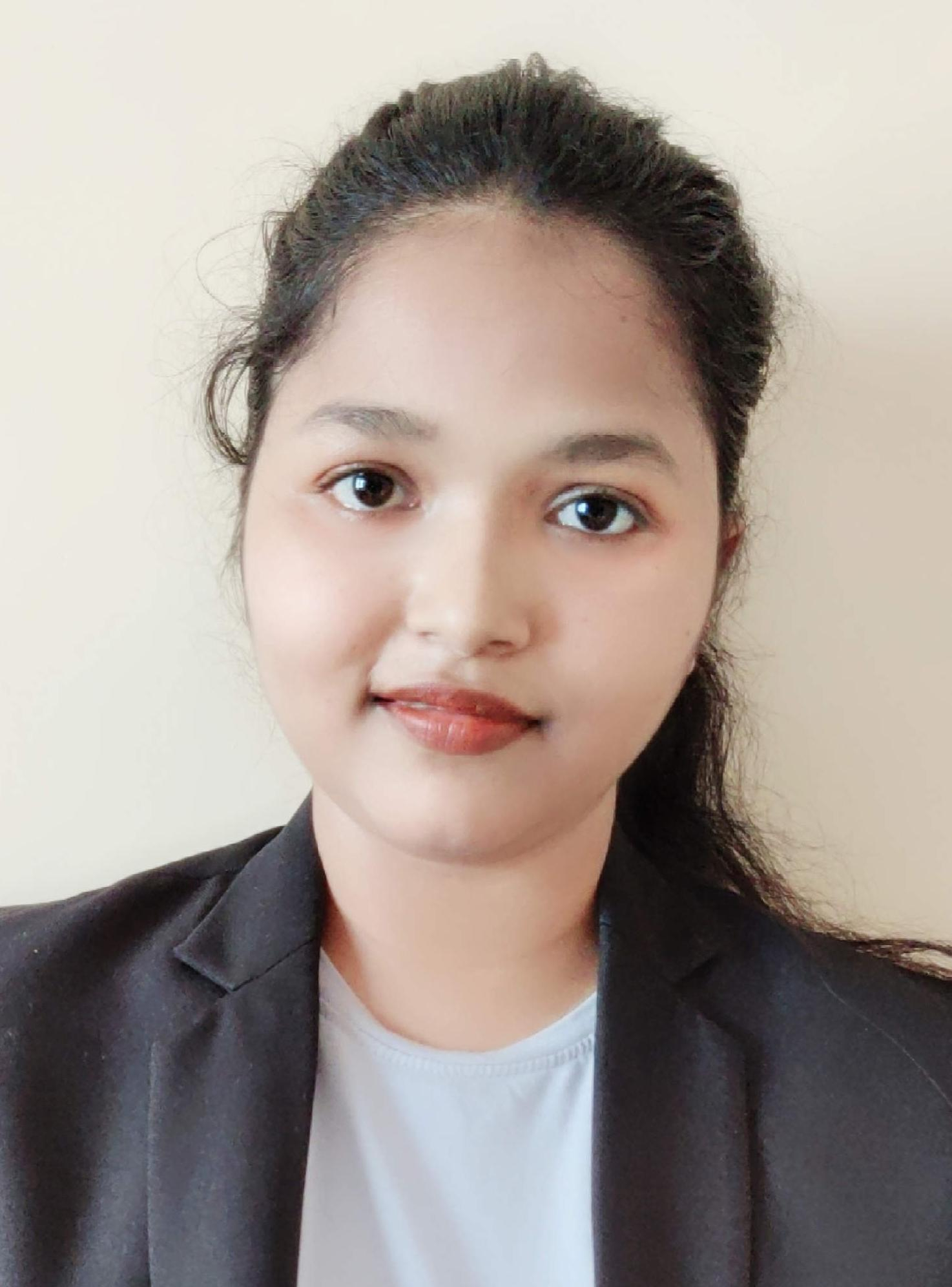
Barkha Bale
PhD Student
Office: B416
E-mail: This email address is being protected from spambots. You need JavaScript enabled to view it.
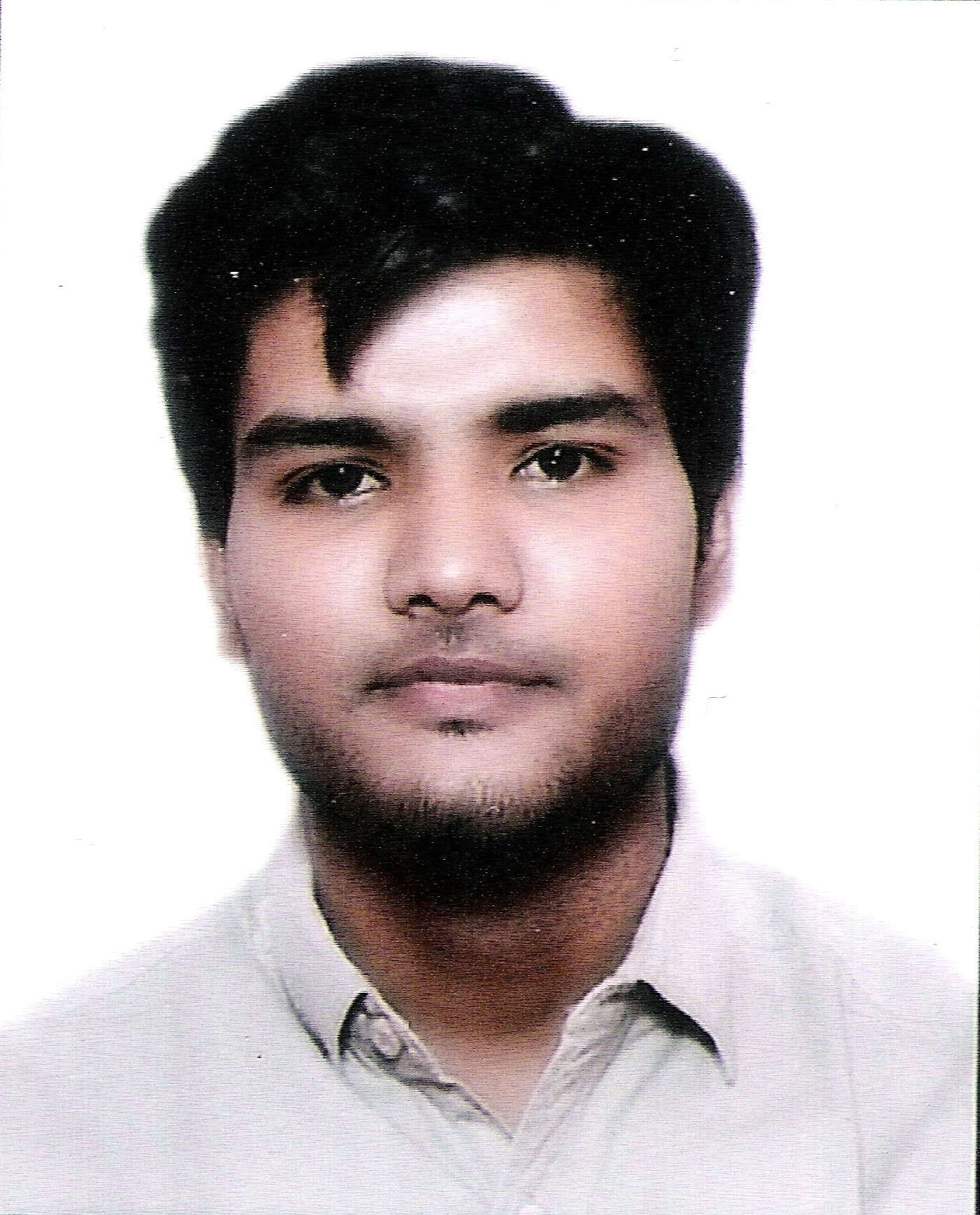
Ashutosh Sharma
PhD Student
Office: B416
E-mail: This email address is being protected from spambots. You need JavaScript enabled to view it.
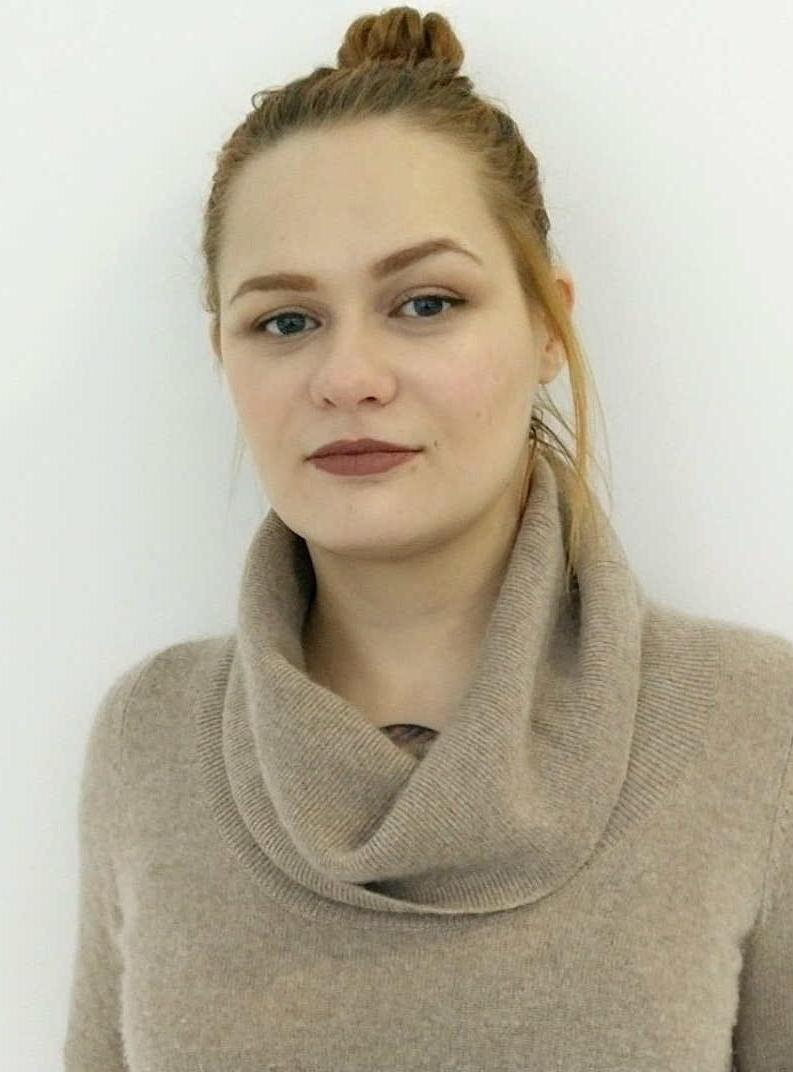
Rūta Urbonavičiūtė
PhD Student
Office: A401
Phone: +370 5 2234636
E-mail: This email address is being protected from spambots. You need JavaScript enabled to view it.
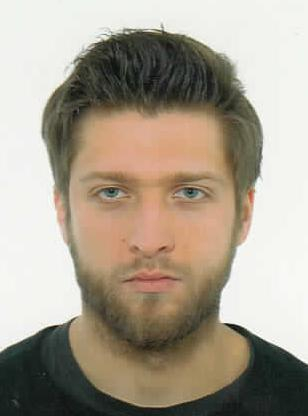
Vilius Bagdonas
PhD Student
Office: B416
E-mail: This email address is being protected from spambots. You need JavaScript enabled to view it.
Website: https://www.ff.vu.lt/en/itpa/staff/bagdonas
Joomla! is all about allowing you to create a site that matches your vision. The possibilities are limitless; this sample site will get you started.
There are a few things you should know to get you started.
Every Joomla! Web site has two parts: the Site (which is what your site visitors see) and the Administrator (which is where you will do a lot of the site management). You need to log in to the Administrator separately with the same username and password. There is a link to the administrator on the top menu that you will see when you log in.
You can edit articles in the Site by clicking on the edit icon. You can create a new article by clicking on the Create Article link in the top menu.
To do basic changes to the appearance your site click Home, Site Settings and Home, Template Settings.
To do more advanced things, like edit the contact form, manage users, or install a new template or extension, login to the Administrator.
Some quick tips for working in the Administrator
- To change the image on all the pages: Go to the Module Manager and click on Image Module.
- To edit the Side Module: Go to Extensions, Module Manager and click on Side Module.
- To edit the Contact Form: Go to Components, Contacts. Click on Your Name.
Once you have your basic site you may want to install your own template (that controls the overall design of your site) and then, perhaps additional extensions.
There is a lot of help available for Joomla!. You can visit the Joomla! forums and the Joomla! documentation site to get started.

